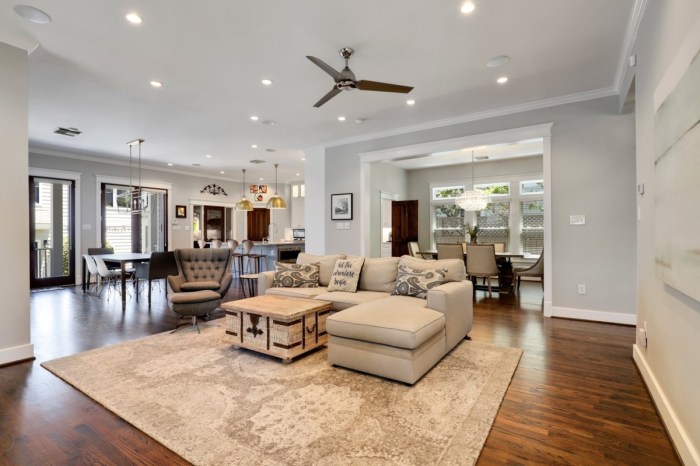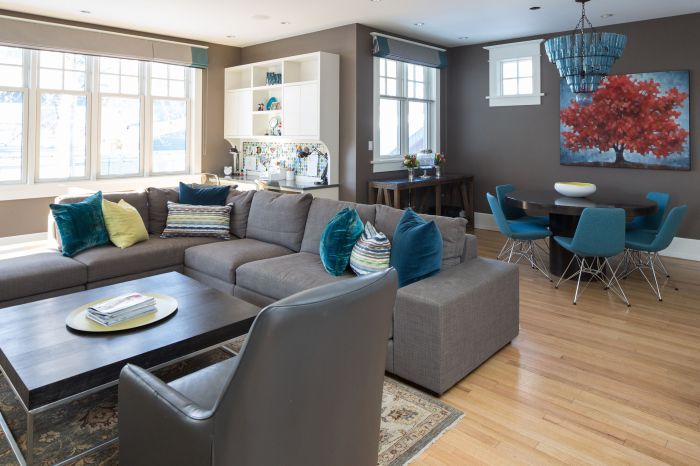Interior layout ideas for open concept homes: A Comprehensive Guide

Exploring the world of interior layout ideas for open concept homes, this introduction sets the stage for a deep dive into the key design principles, furniture arrangement techniques, lighting solutions, and color schemes that can transform an open concept space into a harmonious and functional living area.
As we navigate through the nuances of creating a cohesive flow between different living spaces, optimizing furniture arrangement, enhancing ambiance with lighting, and playing with color schemes and accents, you'll discover the art of balancing aesthetics and functionality in open concept home design.
Design Principles
When planning the interior layout of open concept homes, there are key design principles to keep in mind to ensure a harmonious and functional space. One important aspect is creating a cohesive flow between different living spaces to maintain a sense of unity and connection throughout the home.
Balancing aesthetics and functionality is also crucial in the design of open concept spaces to ensure that the space not only looks beautiful but also serves its purpose effectively.
Creating a Cohesive Flow
To create a cohesive flow between different living spaces in open concept homes, consider using consistent color schemes, materials, and design elements throughout the space. This helps to tie the various areas together and create a sense of continuity. Additionally, incorporating elements like area rugs, lighting fixtures, and furniture layouts that complement each other can help to define separate zones within the open concept layout while still maintaining a cohesive overall look.
Balancing Aesthetics and Functionality
When designing open concept spaces, it's essential to strike a balance between aesthetics and functionality. While it's important for the space to look visually appealing, it should also be practical and functional for everyday use. Consider the layout of furniture to optimize traffic flow and usability, choose durable materials that can withstand high traffic areas, and incorporate storage solutions to keep the space organized and clutter-free.
By finding the right balance between aesthetics and functionality, you can create a beautiful and livable open concept home that meets both your design preferences and practical needs.
Furniture Arrangement

When it comes to open concept homes, furniture arrangement plays a crucial role in optimizing space and creating a cohesive flow throughout the space. By strategically placing furniture pieces, you can define different areas within the open layout while maintaining a sense of unity and spaciousness.
Optimizing Space with Furniture
In open concept homes, it's essential to consider the scale and proportion of furniture pieces to ensure they fit well within the space. Opt for furniture that is sleek and minimalistic to prevent overcrowding. Arrange furniture in a way that allows for easy movement and clear pathways between different areas.
Consider multifunctional pieces such as ottomans with storage or nesting tables to maximize space efficiency.
Utilizing Area Rugs
Area rugs can be used to define specific areas within an open concept layout, creating visual boundaries without the need for physical walls. Place area rugs under key furniture groupings such as the living room seating area or dining table to anchor the space and add warmth.
Ensure that the size of the rug is proportional to the furniture arrangement to maintain balance and harmony in the room.
Selecting Complementary Furniture Pieces
When selecting furniture pieces for an open concept home, opt for cohesive styles and colors to create a harmonious look throughout the space. Consider pieces with clean lines and open designs to maintain a sense of airiness and flow. Mix and match different textures and materials to add visual interest while ensuring that the furniture pieces complement each other in terms of scale and style.
Lighting Solutions
When it comes to lighting solutions for open concept homes, it's essential to create a cohesive and inviting atmosphere throughout the space. Lighting can help define different zones and highlight focal points, enhancing the overall design and functionality of the layout.
Maximizing natural light is also crucial to make the space feel open and airy.
Different Types of Lighting
- Overhead Lighting: Utilize pendant lights, chandeliers, or recessed lighting to provide general illumination throughout the open space.
- Task Lighting: Incorporate under cabinet lighting in the kitchen, desk lamps in the office area, or reading lights in the living room to enhance functionality in specific areas.
- Accent Lighting: Use wall sconces, track lighting, or picture lights to highlight artwork, architectural features, or other focal points in the space.
Creating Zones and Focal Points
By strategically placing different types of lighting fixtures, you can create distinct zones within an open concept layout. For example, a cluster of pendant lights over the dining table can define the dining area, while a floor lamp next to a cozy reading nook can establish a relaxing corner.
Highlighting focal points such as a fireplace or an accent wall with accent lighting draws attention and adds visual interest to the space.
Maximizing Natural Light
- Window Treatments: Opt for sheer curtains or blinds that allow natural light to filter through while maintaining privacy.
- Mirrors: Position mirrors strategically to reflect natural light and make the space feel brighter and more spacious.
- Open Layout: Avoid obstructing windows or walls that receive natural light to ensure an uninterrupted flow of sunlight throughout the space.
Color Schemes and Accents
When it comes to open concept homes, choosing the right color schemes and accents can make a significant impact on the overall look and feel of the space. The right combination of colors can help define different areas within the open layout while accents can add personality and visual interest.
Trending Color Schemes
- Neutral color palettes: Shades of white, beige, gray, and taupe are popular choices for open concept homes as they create a cohesive and calming atmosphere.
- Monochromatic schemes: Using varying shades of the same color can help create a sense of continuity and flow throughout the space.
- Bold accent walls: Adding a pop of color through an accent wall can help delineate different zones within an open layout while adding a focal point.
Using Color to Define Areas
- Use different colors for different zones: By using distinct color schemes for the living area, dining area, and kitchen, you can visually separate these spaces while maintaining a cohesive look.
- Transition colors: Incorporating transitional colors that blend well with the main color palette can help create a smooth flow between different areas.
Role of Accent Pieces
- Statement furniture: Adding bold-colored furniture pieces like a vibrant sofa or an eye-catching rug can instantly elevate the look of an open concept space.
- Decorative accessories: Incorporating colorful throw pillows, artwork, or decorative items can add personality and create visual interest in the room.
- Natural elements: Using accent pieces made of natural materials like wood, rattan, or plants can bring warmth and texture to the space.
Last Recap

In conclusion, the intricate dance of design elements in open concept homes offers a canvas for creativity and innovation. By incorporating these interior layout ideas, you can truly elevate the style and functionality of your living space, making it a reflection of your unique taste and personality.
FAQ Compilation
How can I create a cohesive flow between different living spaces in an open concept home?
To create a cohesive flow, consider using consistent color palettes, repeating design elements, and incorporating furniture that complements each other across the different areas.
What are some strategies for selecting furniture pieces that complement the open concept design?
Opt for furniture with clean lines and low profiles to maintain an unobstructed view in open concept spaces. Additionally, consider multipurpose furniture that can serve different functions in various areas.
How can I use lighting to create zones and focal points in an open concept layout?
Use a combination of ambient, task, and accent lighting to define different zones within an open concept space. Highlight focal points like artwork or architectural features with strategically placed lighting fixtures.
What role do accent pieces play in open concept spaces?
Accent pieces add personality and visual interest to open concept areas. They can serve as focal points, tie together different design elements, and inject a pop of color or texture into the space.

